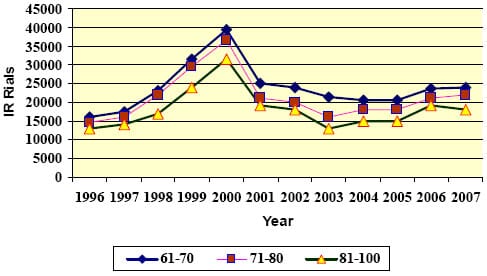WSSV, which was first discovered in Southeast Asia around 1992, is currently the most serious viral pathogen of shrimp worldwide. It causes up to 100% mortality within 7 to 10 days in commercial shrimp farms, resulting in large economic losses to the shrimp farming industry1. Shrimp culture has been a booming business since the beginning of the 1990s, and worldwide production was 1 million metric tonnes in 20022, increased to almost 2.4 million tonnes in Asia by 20083. The shrimp farming industry is an important source of economic development and provides well-paid employment in poor coastal areas.
From the 1990-1995, potential areas for shrimp culture development were surveyed in Iran, comprising some 2,000 km of coastline and more than 110,000 ha of cultivable area. Prior to 2001, more than 7,000 ha of shrimp ponds had been constructed and 11,000 ha were under construction. The main native species produced under semi intensive systems was the Indian white shrimp (Penaeus indicus). However, since outbreaks of WSSV farmers have changed to white leg shrimp (Litopenaeus vannamei) in Khuzestan and Bushehr provinces. Shrimp culture development has taken place along the coastal areas of the Persian Gulf and the Gulf of Oman, where the soils are alkaline and infertile and the water is alkaline (37-42 ppt). Salinity increases up to 47-50 ppt in the ponds and air temperature reaches 50°C. These are generally considered harsh conditions, but the Indian white shrimp and white leg shrimp not only survive but seem also to thrive very well.
The sustainability of shrimp farming has become a major concern among the small-scale coastal farmers in Iran, as the sector has experienced widespread disease problems for four or five consecutive years. In 2002, an outbreak of disease of cultured Indian white shrimp occurred in semi-intensive farms in Abadan (Khuzestan province), southwestern Iran, where it caused losses of almost 100 percent of production. Later WSSV disease occurred in all shrimp sites in Bushehr province, where it severely affected small-scale farms practicing high stocking density, resulting in great economic loss. In 2007, an outbreak of disease of cultured Indian white shrimp occurred in semi-intensive farms in shrimp site of Goater (Sistan and Baluchestan province), southeastern Iran.
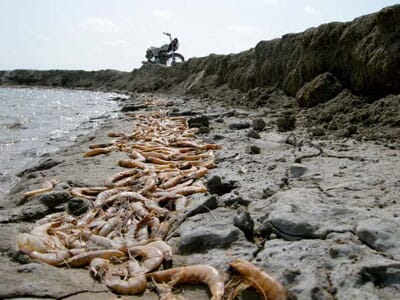
Production and export of shrimp play a dominant role in the fisheries economy in southern Iran; the shrimp sector was the second largest contributor to fisheries export earnings. Per ha production increased from almost 500 kg in 1993 to 2,300 kg in 2002. Since 2003, the effect of WSSV has caused a decline of per ha production in shrimp farming in Iran. In 2005, yield in Bushehr had declined to almost 1,000 kg / ha5. Besides the reduction in export income, the disease outbreaks that took place in 2002, 2005, and 2007 also caused liquidity problems among farm operators. Many shrimp hatcheries, shrimp farms and shrimp processing factories could not make bank payments on their loans. This led lenders, especially the Agriculture Bank, to come up with a loan rescheduling programme for shrimp farmers.
Shrimp culture development in Iran
In Iran, shrimp farming started about 15 years ago and it has undoubtedly seen great experience over this time. Shrimp farms are located along the 2,000 km coastline in the southern parts of Iran from Abadan (Khuzestan province) in the southwest through Bushehr province, Hormozghan province and finally to Goater (Sistan and Baluchestan province) in the southeast, near the border of Pakistan. Since 1991, the Fisheries Organization of Iran has initiated development of marine shrimp farming in the southern coast provinces. Initial trials were carried out with FAO/UNDP assistance in the years 1991-92, producing post-larvae of local species such as P. semisulcatus, P. merguiensis and M. affinis and reviewing favourable areas for shrimp culture. The development of shrimp culture in the region attracted considerable investment and expanded very fast, however there is still a long way to meet the goals of the national development plan. Though the potential of shrimp culture to expand may be apparent, it may be constrained by market demand and producer profitability. From 1992-2002 the sector had undoubtedly seen great success, but since 2002 production has declined due to the impact of WSSV.
Provincial production
in 1993 to more than 7,600 tonnes in 2001 before declining to 6,000 tonnes in 20026, with a recovery to 9,000 tonnes in 2004 and further declines in 2005 and 20075. In Khuzestan province, shrimp farming production increased from less than 10 tonnes in 1993 to the highest level of production of more than 2,050 tonnes in 2001. In 2002, an outbreak of WSSV disease caused loss of all production. Over the four years from 2003 - 2007, all governmental effort including introduction of new species of white leg shrimp increased production to 70 tonnes. In Bushehr province, shrimp farming production increased from less than 1 tonne in 1993 to 5,600 tonnes in 2004. In 2005, an outbreak of WSSV disease caused losses of great economic loss and production declined to almost 475 tonnes. Introduction of white leg shrimp increased production to 1,623 tonnes in 2006 and 876 tonnes in 2007. WSSV did not affect the Hormozgan province, though, where the production trend is almost constant. In Sistan and Baluchestan province, shrimp farming production increased from less than 1 tonne in 1993 to 2,500 tonnes in 2006, In 2007, an outbreak of WSSV disease caused losses of great economic loss and production declined to almost 16 tonnes in 2007 (Table, 1).
Shrimp farming production and exports
The area of shrimp farming rose from 2 ha in 1992 to more than 3,660 ha in 2001 before declining to 2,650 ha in 20029, increasing again to 3,600 and 4,270 ha in 2003 and 2004 respectively (Figure 1). Since 2005, the areas of operating farms have again started to decline and fell to almost 1,000 ha in 2007. However, more than 7,000 ha of farms were constructed and more than 11,000 ha were also under construction, although the active area did not increase more than 4,250 ha. Over the 1993-2004 periods, the number of farms increased from 12 farms to 310 farms, declining to almost 200 farms in 2006-2007. The average area of operating ponds per farm was less than 3 ha in 1993 and increased to almost 14 ha over the 2003-2006, declining dramatically to less than 6 ha by 2007 (Figure 2). Since 2001, farm gate price has declined almost 40% (Figure 3) and some companies have left the industry. In Iran, the inflation rate averaged between 12 to 24 percent over the 1997 to 2007 periods. The inflation rate was also negatively affected shrimp industry and caused for losses of companies.
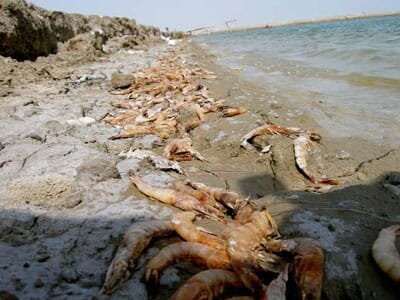
Throughout the end 1990s, the shrimp sector grew dramatically in response to global demand. Iran produces 9,000 tonnes of farmed shrimp in 20046. However, over the years 2002-2007, the exportation of cultured shrimp has declined, due mainly to disease outbreaks. In 2000, 2003 and 2004, from both captured and cultured shrimp Iran earned (US$22.9 million, US$32.6 million and US$32.8 million) by exporting 7,860 tonnes, 6,630 tonnes and 7,680 tonnes of frozen shrimp respectively, while in 2005, 2006 and 2007, Iran exported only 1,920 tonnes, 2,980 tonnes and 2,290 tonnes and earned (US$7.2 million, US$13 million tonnes and US$8.7 million).
Conclusions and recommendations
Since 2002, WSSV disease has caused losses of production and export income of shrimp farming industry in three main shrimp farming areas of coastal southern provinces in Iran. Overall, small-scale shrimp farmers in the coastal area in all southern provinces are presently in a poor state. The fl ow of capital between the shrimp farmers and related financial support activities has almost stopped. Measures need to be taken to assist shrimp farmers and other related industries such as hatcheries, feed factories and processing factories; otherwise this potentially valuable sector will disappear from this area.
| Table 1: Shrimp farming production in four coastal provinces over the 1993-2007 in south Iran. | ||||||||||||
|---|---|---|---|---|---|---|---|---|---|---|---|---|
| Province | 1993 | 1995 | 1997 | 1999 | 2000 | 2001 | 2002 | 2003 | 2004 | 2005 | 2006 | 2007 |
| Khuzestan | 8.6 | 35 | 114 | 491 | 850 | 2054 | 0 | 26 | 21 | 0 | 17 | 70 |
| Bushehr | 0.6 | 63 | 296 | 1,062 | 1,955 | 3,334 | 3,788 | 3,585 | 5,600 | 476 | 1623 | 876 |
| Hormozgan | 6.6 | 32 | 106 | 205 | 850 | 1,213 | 872 | 1,737 | 2,004 | 1,284 | 1,560 | 1,538 |
| Sistan and Baluchestan |
0.5 | 5 | 3 | 69 | 355 | 1,023 | 1,300 | 2,114 | 1,278 | 1,800 | 2,500 | 16 |
| Total | 16.3 | 135 | 517 | 1,858 | 4,010 | 7,624 | 5,960 | 7,462 | 8,903 | 3,560 | 5,700 | 2,500 |
| Sources: Salehi, 2003, PDD, 2002, 2004 & 2005 and Fisheries of Iran, 2008. | ||||||||||||
Recommendations include:
- Extension activities, which need to be within the farmers’ reach. An informed extension service and a routine reporting system should be in place. Co-ordination of experts, extension workers, investment agencies and farmers is urgently required.
- Farm management and management strategies should be adopted at the conception of the shrimp farm, including pond preparation, the use of fine screens at inlets, maintenance of standard stocking densities and implementation of a water management system. In the case of imported brood stock and post-larvae, proper checking should be carried out before importation is also allowed.
- Network building, including a co-operative network to address shrimp diseases should be further developed that includes research, extension, field investigation, information exchange and preventative measures.
- If it is possible, alternative income generation activities should be supported and provisions should be made for small-scale shrimp farmers and hatchery centers to explore, and engage in, alternative activities.
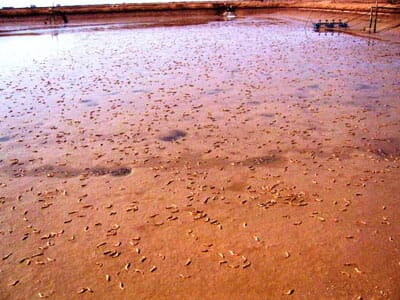
Figure 1: Area and production of shrimp farming from 1993-2007 in Iran.
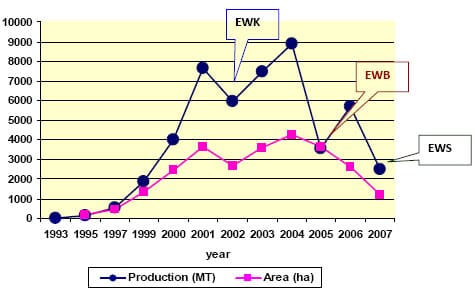
Figure 2: Number of operating farms and average area of ponds per farm from 1993-2007 in Iran.
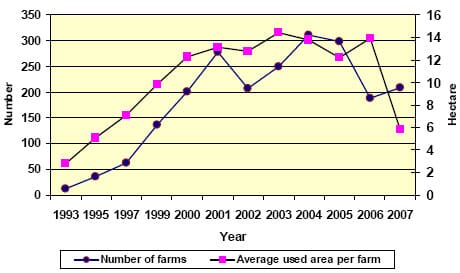
Figure 3: Farm gate price IR Rials per kg. of shrimp production from 1996-2007 in Iran.
